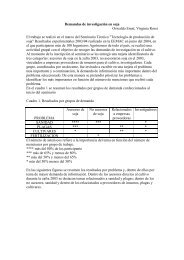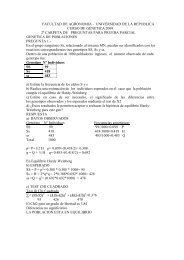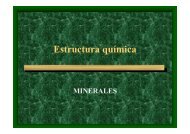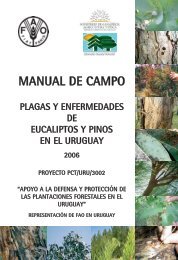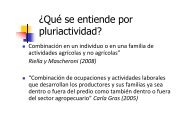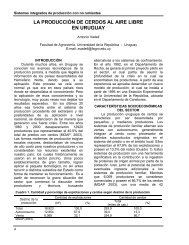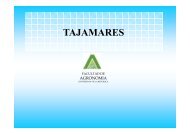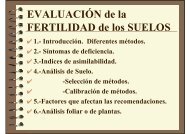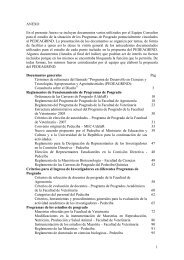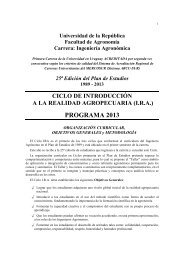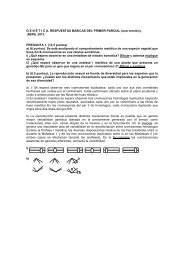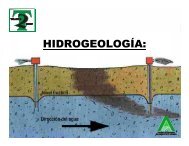Reproductive Biology of Butea monosperma ... - Annals of Botany
Reproductive Biology of Butea monosperma ... - Annals of Botany
Reproductive Biology of Butea monosperma ... - Annals of Botany
You also want an ePaper? Increase the reach of your titles
YUMPU automatically turns print PDFs into web optimized ePapers that Google loves.
<strong>Annals</strong> <strong>of</strong> <strong>Botany</strong> 92: 715±723, 2003<br />
doi:10.1093/aob/mcg193, available online at www.aob.oupjournals.org<br />
<strong>Reproductive</strong> <strong>Biology</strong> <strong>of</strong> <strong>Butea</strong> <strong>monosperma</strong> (Fabaceae)<br />
RAJESH TANDON1, *, K. R. SHIVANNA2 and H. Y. MOHAN RAM3 1Department <strong>of</strong> <strong>Botany</strong>, University <strong>of</strong> Delhi, Delhi 110 007, India, 2Ashoka Trust for Research in Ecology and the<br />
Environment 659, 5A Main Road, Hebbal, Bangalore 560 024, India and 3Centre for Environmental Management <strong>of</strong><br />
Degraded Ecosystem, University <strong>of</strong> Delhi, Delhi 110 007, India<br />
Received: 23 April 2003 Returned for revision: 18 June 2003 Accepted: 28 July 2003 Published electronically: 19 September 2003<br />
The reproductive biology encompassing phenology, ¯oral biology, pollination and breeding systems, <strong>of</strong> <strong>Butea</strong><br />
<strong>monosperma</strong>, a beautiful tree <strong>of</strong> the Indian subcontinent, was investigated in a protected dry, deciduous forest<br />
located in New Delhi. Phenological studies indicated that although the species shows a regular ¯owering season,<br />
all trees do not ¯ower every year. Flowers are typically papilionaceous; the stigma is wet papillate and the style<br />
is hollow. The ¯owers show characteristics <strong>of</strong> bird pollination being large and bright orange-red in colour with<br />
copious amounts <strong>of</strong> nectar, and exhibiting diurnal anthesis. Although the ¯owers are frequented by as many as<br />
seven species <strong>of</strong> birds belonging to six families, only one species, the purple sunbird (Nectarinia asiatica), is the<br />
effective pollinator. The ¯owers are also pollinated by the three-striped squirrel (Funambulus tristiatus). Unlike<br />
other ¯ower visitors, these two pollinators forage the nectar from the open side <strong>of</strong> the keel (legitimate path) during<br />
which pollen grains are deposited on their body parts. After the ®rst visit <strong>of</strong> a sunbird or a squirrel, virgin<br />
¯owers showed pollen load on the stigma and developed into fruits. B. <strong>monosperma</strong> shows a weak form <strong>of</strong> selfincompatibility.<br />
Fruit set following manual self-pollination (5´25 %) was comparable with open-pollination<br />
(approx. 5 %) but was signi®cantly lower than manual cross-pollination (22´51 %). This indicates that there is a<br />
high degree <strong>of</strong> geitonogamous pollination in this species, which may lead to a weakening <strong>of</strong> self-incompatibility<br />
as a means <strong>of</strong> reproductive assurance. The results are analysed in the light <strong>of</strong> prevailing discussions on specialized<br />
vs. generalized pollination systems. ã 2003 <strong>Annals</strong> <strong>of</strong> <strong>Botany</strong> Company<br />
Key words: Breeding system, <strong>Butea</strong> <strong>monosperma</strong> (Lam.) Taub., ¯oral biology, ornithophily, squirrel-pollination, tree<br />
legume.<br />
INTRODUCTION<br />
The reproductive biology <strong>of</strong> ¯owering plants is important<br />
for determining barriers to seed and fruit set, for conservation,<br />
and for understanding pollination and breeding<br />
systems that regulate the genetic structure <strong>of</strong> populations.<br />
Detailed studies on reproductive biology <strong>of</strong> Indian plant<br />
species, especially trees, are limited. Out <strong>of</strong> nearly 2500 tree<br />
species reported from India, 180 are leguminous (Dr M.<br />
Sanjappa, Director, Botanical Survey <strong>of</strong> India, pers. comm.)<br />
being predominantly pollinated by bees. There are very few<br />
species that are pollinated by birds.<br />
According to a survey on ornithophilous species in India,<br />
93 are regularly visited by 58 species <strong>of</strong> birds (Subramanya<br />
and Radhamani, 1993). Over 80 % <strong>of</strong> these plant species are<br />
frequented by more than one species <strong>of</strong> bird and, similarly,<br />
over 80 % <strong>of</strong> the bird species visit more than one plant<br />
species. Thus, a generalized relationship exists between<br />
plant species and bird pollinators (Subramanya and<br />
Radhamani, 1993; Waser et al., 1996). In the majority <strong>of</strong><br />
ornithophilous species, no attempts have been made to<br />
establish the obligate necessity <strong>of</strong> birds for pollination and<br />
to distinguish pollinators from ¯oral visitors. More intensive<br />
studies are needed on Indian species for a better understanding<br />
<strong>of</strong> bird-pollination systems.<br />
* For correspondence. E-mail rjtnd@rediffmail.com<br />
<strong>Butea</strong> <strong>monosperma</strong> (Lam.) Taub (Fabaceae) is a mediumsized<br />
tree <strong>of</strong> the Indian sub-continent. It is an important<br />
species that yields several non-timber forest products, such<br />
as a water-soluble dye, lac resin, fodder and leaves for<br />
platters (Anon., 1988). The plant has beautiful ¯owers<br />
adorning lea¯ess canopies during early summer and is aptly<br />
described as `the ¯ame <strong>of</strong> the forest'. The ¯ower colour has<br />
been variously described as scarlet, red and orange-red<br />
(Anon., 1983, 1988, 1994) but, according to the Royal<br />
Horticultural Society colour chart (Anon., 1946), is most<br />
accurately termed Indian-orange. Although rare, yellow and<br />
white ¯owering trees have also been reported (Sanjappa,<br />
1987). Except for a report by Ali (1932) based on<br />
observations that several bird species visit the ¯owers,<br />
there have been no systematic studies on the reproductive<br />
biology <strong>of</strong> B. <strong>monosperma</strong> implicating bird pollination. The<br />
tree is largely propagated by seeds. Fruit set is very low and<br />
each fruit bears only one seed (hence the speci®c epithet<br />
<strong>monosperma</strong>).<br />
In recent years, there has been a discussion on generalization<br />
vs. specialization in pollination systems (Waser<br />
et al., 1996; Johnson and Steiner, 2000). In B. <strong>monosperma</strong>,<br />
as many as 12 bird species have been reported to visit<br />
¯owers (Subramanya and Radhamani, 1993). These features<br />
®t into the generalized relationship between ¯owers and bird<br />
pollinators. However, unlike many <strong>of</strong> the species pollinated<br />
by passerine birds in which ¯owers are open-type and have<br />
unprotected nectar, B. <strong>monosperma</strong> bears ¯owers in which<br />
<strong>Annals</strong> <strong>of</strong> <strong>Botany</strong> 92/5, ã <strong>Annals</strong> <strong>of</strong> <strong>Botany</strong> Company 2003; all rights reserved
716 Tandon et al. Ð <strong>Reproductive</strong> <strong>Biology</strong> <strong>of</strong> <strong>Butea</strong> <strong>monosperma</strong><br />
Stage<br />
the nectar is concealed within the keel and requires a special<br />
foraging effort by the vector. Thus, a specialized relationship<br />
between the structural organization <strong>of</strong> the ¯ower and<br />
the pollinator is implicated.<br />
The present work on B. <strong>monosperma</strong> covers (a) the<br />
structural and temporal details <strong>of</strong> ¯owers to understand their<br />
relationship with pollination and fruit set, (b) pollination<br />
biology, (c) the breeding system and (d) fruit and seed<br />
biology. As the ¯owers are visited by several bird species,<br />
studies on pollination biology were aimed speci®cally at<br />
distinguishing ¯oral visitors from pollinators and studying<br />
the involvement <strong>of</strong> any other vector in the pollination <strong>of</strong> this<br />
species.<br />
Study site<br />
TABLE 1. Developmental stages <strong>of</strong> ¯owers <strong>of</strong> <strong>Butea</strong> <strong>monosperma</strong> identi®ed for pollination studies<br />
Days to (±)/after<br />
(+) anthesis<br />
MATERIALS AND METHODS<br />
The study site is located (between 28°40¢±28°35¢N and<br />
77°10¢±77°30¢E) in the Central Ridge Forest (CRF), representing<br />
the northern part <strong>of</strong> the Aravalli range in New Delhi.<br />
There are about 200 wild and sparsely distributed <strong>Butea</strong><br />
<strong>monosperma</strong> trees in the CRF. Other trees that occur within<br />
the study site include Acacia leucophloea, A. modesta,<br />
Balanites roxburghii, Cordia dichotoma, Erythrina indica,<br />
Ehretia laevis, Prosopis juli¯ora, Wrightia tinctoria and<br />
Zizyphus mauritiana (Maheshwari, 1963).<br />
Phenology and ¯oral biology<br />
Flower length<br />
(cm)<br />
Thirty trees were marked at various locations within the<br />
CRF for phenological studies. Of these, ten (marked B1±<br />
B10) were selected for detailed studies on ¯oral biology,<br />
breeding system and pollination ecology.<br />
Phenological events (bud break, ¯owering, fruiting,<br />
shedding <strong>of</strong> leaves, fresh leaf emergence, fruit dispersal<br />
and seed germination) were recorded over a period <strong>of</strong> two<br />
¯owering seasons (1996 and 1997). To obtain the above<br />
Colour and external<br />
features Internal features<br />
S1 ±1* 4´5±5´4 Wing petals not<br />
Anthers not dehisced, nectar<br />
expanded<br />
absent<br />
S2 ±1[+6±9 h] 4´5±5´4 Wing petals not<br />
expanded<br />
Anthers dehisced, nectar absent<br />
S3 0** 5´0±6´0 Anthesis beginning;<br />
Stigma receptive, nectar<br />
expansion <strong>of</strong> wing<br />
present, natural pollination<br />
petals and bending <strong>of</strong><br />
the vexillum<br />
occurs<br />
S4 0 [+2 h] ² 5´0±6´0 Flower fully opened Stigma receptive, nectar<br />
present, natural pollination<br />
occurs<br />
S5 +2 5´0±6´0 Petals and sepals start<br />
shrivelling, petal colour<br />
faded<br />
Ovary swollen<br />
* Floral stage selected for emasculation.<br />
² Stages for manual pollinations.<br />
information, observations were made every day in the<br />
morning hours during the ¯owering period (February±<br />
April). Subsequent events, such as fruit maturation and fruit<br />
dispersal, were noted and recorded once a week.<br />
The average numbers <strong>of</strong> ¯ower borne on an in¯orescence<br />
were recorded from a set <strong>of</strong> randomly tagged ¯owering<br />
branches (n = 30). Five developmental stages (S1±S5) were<br />
recognized on the basis <strong>of</strong> morphometry, time <strong>of</strong> anther<br />
dehiscence and period <strong>of</strong> stigma receptivity. The details are<br />
presented in Table 1 and the speci®c stages used for<br />
emasculation and manual pollinations are speci®ed. For<br />
estimating the average pollen grain numbers produced in a<br />
¯ower, mature but undehisced anthers (n = 20) were<br />
squashed in two or three drops <strong>of</strong> 25 % glycerol (v/v) + 1<br />
drop <strong>of</strong> 1 % acetocarmine. Pollen grain viability at the time<br />
<strong>of</strong> anther dehiscence and later stages was estimated using<br />
the ¯uorescein diacetate (FDA) test (Heslop-Harrison and<br />
Heslop-Harrison, 1970). The presence <strong>of</strong> starch or lipids as a<br />
reserve material in the pollen grains was determined using<br />
I2KI and Sudan III+IV (Dafni, 1992), respectively.<br />
On the stigmatic surface, non-speci®c esterases were<br />
localized using a-naphthyl acetate (Mattsson et al., 1974)<br />
and phosphatases using a-naphthyl acid phosphate<br />
(Scandlios, 1969) as substrates. Stigma receptivity and<br />
temporal details <strong>of</strong> post-pollination events were recorded<br />
using the method described by Shivanna and Rangaswamy<br />
(1992). Pollen germination and pollen tube growth were<br />
examined using the aniline blue ¯uorescence method<br />
(Shivanna and Rangaswamy, 1992).<br />
Structural details <strong>of</strong> the stigma and style were investigated<br />
using resin-embedded sections (3 and 4 mm thick)<br />
(Fedder and O'Brien, 1968). The cuticle was localized using<br />
auramine O (Heslop-Harrison, 1977), proteins using<br />
Coomassie brilliant blue R (Fisher, 1968), insoluble<br />
polysaccharides using PAS reagent (McGukin and<br />
Mackenzie, 1958), pectins using alcian blue (Heslop-<br />
Harrison, 1979) and lipids using auramine O (Heslop-<br />
Harrison, 1977). Ovule number was determined by clearing
Tandon et al. Ð <strong>Reproductive</strong> <strong>Biology</strong> <strong>of</strong> <strong>Butea</strong> <strong>monosperma</strong> 717<br />
the fresh pistils (n = 20) with NaOH (1 N) and staining with<br />
1 % acetocarmine.<br />
Pollination<br />
Nectar production was estimated every hour between<br />
0500 and 1800 h. Flowers at the S2 stage (n = 25) were<br />
randomly selected on ®ve trees and bagged (butter paper<br />
bags, 10 3 5 cm) 1 d before initiation <strong>of</strong> nectar production.<br />
On the day <strong>of</strong> anthesis, nectar was collected by gently<br />
inserting a calibrated micropipette through the opening <strong>of</strong><br />
the keel. Flowers were re-bagged after each collection.<br />
Temporal activities <strong>of</strong> the ¯oral visitors were recorded<br />
between 0430 and 1900 h over a 1-week period in each<br />
season, using a pair <strong>of</strong> ®eld binoculars. Each ¯oral visitor<br />
was carefully observed for the time spent on each ¯ower,<br />
and its mode <strong>of</strong> foraging noted. A distinction was made<br />
between the legitimate (those which foraged through the<br />
open margin <strong>of</strong> the keel petals) and the destructive (those<br />
which consumed nectar either by making a hole in the calyx<br />
or by damaging the ¯oral parts) foragers. Pollination<br />
ef®ciency was assessed by exposing virgin ¯owers to a<br />
single visit by a vector and studying pollen load on the<br />
stigma and also by fruit production (Schemske and<br />
Horovitz, 1984). To study pollen load, stigmas from ¯owers<br />
visited by legitimate foragers (n = 10 each for sunbird and<br />
squirrel) were carefully excised in the ®eld, placed on damp<br />
cotton in a screw-capped vial (Tandon et al., 2001) and<br />
brought to the laboratory. A liquid ®xative was deliberately<br />
not used in order to prevent dislodging <strong>of</strong> pollen grains. The<br />
stigma was carefully mounted in a drop <strong>of</strong> auramine O (a<br />
¯uorescent dye for pollen exine) and observed under a<br />
¯uorescence microscope. Pollen grains that were in contact<br />
with the stigma, as well those dislodged from the stigma,<br />
were counted. To determine pollination ef®ciency, a set <strong>of</strong><br />
48 freshly opened ¯owers which were legitimately foraged<br />
by squirrels (n = 30) and sunbirds (n = 18) were bagged and<br />
tagged to monitor fruit set.<br />
Breeding system<br />
On the basis <strong>of</strong> stigma receptivity, ¯oral stages S3 and S4<br />
were used for carrying out manual pollinations in the ®eld.<br />
As fruit set under open-pollination in this species is very low<br />
(approx. 5 %), the number <strong>of</strong> pollinations for each treatment<br />
had to be increased substantially to get a clear picture. To<br />
prevent autogamy, ¯owers were emasculated at the S1 stage<br />
using a ®ne pair <strong>of</strong> forceps and then bagged. The bags were<br />
opened on the day <strong>of</strong> anthesis and the ¯owers manually<br />
pollinated by gently brushing the receptive stigma with<br />
freshly dehisced anthers after which the ¯owers were rebagged.<br />
To effect cross-pollination on emasculated and<br />
bagged ¯owers (n = 604), pollen grains were used from<br />
different trees and for geitonogamous self-pollinations (n =<br />
495) pollen grains were applied from other ¯owers <strong>of</strong> the<br />
same tree. To investigate any possible occurrence <strong>of</strong><br />
apomixis, ¯owers at the S1 stage (n = 200) were emasculated<br />
and bagged without pollination. Spontaneous autogamy<br />
(n = 138) was tested by bagging unpollinated and<br />
unemasculated ¯owers.<br />
In all manual pollinations, the bags were removed after<br />
48 h to monitor ¯ower retention. The index <strong>of</strong> selfincompatibility<br />
(ISI) was expressed as the ratio <strong>of</strong> the<br />
number <strong>of</strong> fruits formed through manual self-pollination to<br />
those formed through manual cross-pollination (Zapata and<br />
Arroyo, 1978) at the end <strong>of</strong> 18±20 d. By randomly tagging<br />
the ¯owering branches (n = 100) on 25 trees in the<br />
population, the total number <strong>of</strong> ¯ower buds borne and the<br />
number <strong>of</strong> fruits that developed were computed.<br />
Fruit dispersal distance was computed by marking ®ve<br />
isolated trees at different locations within the population. A<br />
red dot (4±5 mm diameter) was placed on the mature fruit<br />
(n = 50 each, on ®ve separate marked individuals), close to<br />
the pedicel, when they were still attached to the tree. The<br />
distance travelled by fruits after their dispersal was measured<br />
from the base <strong>of</strong> the trunk <strong>of</strong> respective trees. Fruit<br />
densities at various distances from the tree were measured<br />
by laying down quadrats. Student's t-test (Sokal and Rohlf,<br />
1969) was performed to establish the signi®cance <strong>of</strong> the<br />
difference between the fruit set through manual cross- and<br />
self-pollination on marked trees.<br />
Phenology<br />
RESULTS<br />
Trees marked for phenological observations (n = 30)<br />
showed variation with respect to leaf fall and ¯owering.<br />
Twenty-seven trees ¯owered in the ®rst year but only 18 did<br />
so in the second. Trees marked for manual pollination<br />
¯owered in both years. The trees that ¯owered began to shed<br />
their foliage in December and were completely bare by<br />
January. However, those that failed to ¯ower retained their<br />
leaves. Occasionally, trees that ¯owered retained a scanty<br />
amount <strong>of</strong> foliage, especially on the lower branches.<br />
The inception <strong>of</strong> in¯orescence primordia in the leaf axils<br />
occurred at the end <strong>of</strong> February. The ¯ower buds were black<br />
and velvety, and commenced opening during the ®rst/<br />
second week <strong>of</strong> March. Peak ¯owering time in both years<br />
was the ®rst week in April, trees remaining in bloom for<br />
6±8 weeks. Fruiting commenced from the last week <strong>of</strong><br />
March to the ®rst week <strong>of</strong> April, the fruits reaching maturity<br />
by the end <strong>of</strong> May and dispersing in mid-June. Seeds were<br />
not liberated from the fruits. Leaf primordia appeared in<br />
April/May and leaves attained their maximum size by May/<br />
June.<br />
At the study site, B. <strong>monosperma</strong> shared its ¯owering<br />
period with that <strong>of</strong> other trees such as Ehretia laevis<br />
(Ehretiaceae) and Bauhinia variegata (Caesalpiniaceae).<br />
The declining ¯owering phase <strong>of</strong> B. <strong>monosperma</strong> coincided<br />
with the peak ¯owering phase <strong>of</strong> Erythrina indica<br />
(Fabaceae), another nectariferous tree with bright scarlet<br />
¯owers that attract birds.<br />
Floral biology<br />
The in¯orescence <strong>of</strong> B. <strong>monosperma</strong> is a pr<strong>of</strong>usely<br />
branched, fascicled, paniculate raceme, 20´97 6 5´21 cm<br />
(n = 30) in length. On average, an in¯orescence developed<br />
166´21 6 53´31 (n = 30) ¯owers that opened in acropetal
718 Tandon et al. Ð <strong>Reproductive</strong> <strong>Biology</strong> <strong>of</strong> <strong>Butea</strong> <strong>monosperma</strong><br />
F IG. 1. A±D, Transverse sections <strong>of</strong> a style at different levels: just below the stigma (A), about 2 mm below the stigma (B), middle (C) and lower<br />
portion <strong>of</strong> the style. The style is solid just below the stigma; the stylar canal appears a few millimetres below the stigma and merges with the terminal<br />
part <strong>of</strong> the ovarian cavity. Bar = 125 mm. E, Enlarged view <strong>of</strong> transverse section <strong>of</strong> a style below the solid portion showing a canal formed as a result<br />
<strong>of</strong> lysis (arrows) <strong>of</strong> a few cells <strong>of</strong> the transmitting tissue. Bar = 65 mm. F, A receptive stigma with intense activity for non-speci®c esterases. Bar =<br />
1 mm. G, Longitudinal section <strong>of</strong> a portion <strong>of</strong> a stigma showing the septate inter-papillar connections (arrows) and stigmatic exudate in the interstices<br />
between the papillae. Bar = 60 mm. H, Scanning electron micrograph <strong>of</strong> a tri-zono-colporate pollen grain presenting a prominent colpus with a germ<br />
pore. The exine is reticulate. Bar = 5 mm. I, Transverse section <strong>of</strong> a mature anther lobe stained with PAS reagent. Note fertile starchy pollen grains<br />
and collapsed sterile pollen grains (arrows). Bar = 65 mm. Abbreviations: al, anther locule; c, colpus; en, exine; ex, exudate, g, starch grains; gp, germ<br />
pore; sc, stylar canal; sg, stigma; st, style; tt, transmitting tissue.<br />
order. Anthesis (¯ower bud opening) occurred between<br />
0900 and 1030 h.<br />
The ¯owers have a typical papilionaceous corolla (see<br />
Fig. 2A). The petals are bright Indian-orange, silvery<br />
tomentose outside and glossy inside. During anthesis, the<br />
standard petal (vexillum) curves backward after the expansion<br />
<strong>of</strong> the wing petals. Each ¯ower lasts 1±2 d. A<br />
gamosepalous cup-like, green and ¯eshy calyx bulges out<br />
behind the standard petal. Of the ten stamens, nine are<br />
united and form a long staminal tube with two nostril-like<br />
openings at the base. The distal end bears nine very short<br />
®laments, each terminating in a bilobed anther. The free<br />
stamen (vexillary stamen) is invariably shorter than the<br />
united stamens and is aligned with the bulged part <strong>of</strong> the<br />
calyx. Nectar is secreted by ®ve nectaries located at the base<br />
<strong>of</strong> the ovary and accumulates in the calyx cup.<br />
Pollen grains are trizonocolporate and the exine is tectatereticulate<br />
(Fig. 1H). The average number <strong>of</strong> pollen grains in
Tandon et al. Ð <strong>Reproductive</strong> <strong>Biology</strong> <strong>of</strong> <strong>Butea</strong> <strong>monosperma</strong> 719<br />
F IG. 2. A, A pair <strong>of</strong> freshly opened ¯owers showing erect keel, fully expanded lateral wings and the standard petal. The stamens and the pistil are<br />
enveloped in the keel. B, A female purple sunbird (solid arrow) withdrawing nectar from the opening <strong>of</strong> the keel (un®lled arrow). C, A three-striped<br />
squirrel foraging freshly opened ¯owers. Pollen can be seen as yellow powder (small arrows) on the snout and the head (inset) <strong>of</strong> the squirrel. D,<br />
Squirrel pollinating a ¯ower. Note that the head <strong>of</strong> the squirrel is in contact with the stigma (long arrow), effecting pollination.<br />
a ¯ower was 52775´49 6 1698´03 (n = 20). Whereas each<br />
anther <strong>of</strong> the nine united stamens contained 5382 6 340´76<br />
pollen grains, the anther from the free stamen bore a slightly<br />
lower number (4334´83 6 329´22). About 37´3 % <strong>of</strong> pollen<br />
grains were sterile. They were shrivelled, lacked cytoplasmic<br />
contents and did not ¯uoresce when stained with FDA.<br />
Fertile and viable grains were 28 6 1´36 mm in diameter,<br />
¯uoresced brightly with FDA and contained starch as<br />
reserve material (Fig. 1I). Each ovary bore 5´43 6 0´6 (n =<br />
30) ovules; and the pollen to ovule ratio was 9719 : 1.<br />
Pistils were 5´19 6 0´13 cm long at maturity and<br />
adaxially curved along the staminal tube. A globose,<br />
papillate and wet stigma is located near the tip <strong>of</strong> the keel,<br />
facing the standard petal. Papillae are unicellular. Young<br />
papillae are covered with a pellicle±cuticle layer and<br />
contain starch grains. At the time <strong>of</strong> anthesis the stigmatic<br />
exudate accumulates in the interstices <strong>of</strong> the papillae<br />
(Fig. 1G). The neighbouring stigmatic papillae are connected<br />
to each other through septate inter-papillar connections<br />
(Fig. 1G). Each papilla is vacuolated and has a large<br />
nucleus.<br />
The style subjacent to the stigma is solid (Fig. 1A). In<br />
transverse section it is 15±20 cells thick and made up <strong>of</strong><br />
cortical cells with a core <strong>of</strong> transmitting tissue (Fig. 1A).<br />
Sections cut a few millimetres below the stigma showed a<br />
narrow stylar canal formed by the disintegration <strong>of</strong> a few<br />
transmitting tissue cells (Fig. 1B and E). The stylar canal<br />
gradually expands towards the base <strong>of</strong> the style and<br />
eventually joins the ovarian cavity (Fig. 1B±D).<br />
Floral rewards and foragers<br />
A pr<strong>of</strong>use amount <strong>of</strong> nectar constitutes the primary ¯oral<br />
reward for the visitors. Nectar is absent at the time <strong>of</strong> anther<br />
dehiscence but accumulates by the time the stigma becomes<br />
receptive. The quantity <strong>of</strong> nectar was measured on the day<br />
<strong>of</strong> ¯ower opening at hourly intervals between 0500 and<br />
1800 h. On average, the total amount <strong>of</strong> nectar collected<br />
during this period in each ¯ower was 73 6 18´31 ml.<br />
Maximum nectar production occurred between 0900 and<br />
1100 h.<br />
Freshly opened ¯owers are brightly coloured and attract a<br />
large number <strong>of</strong> visitors (Table 2). Maximum visitation<br />
occurred between 0900 and 1100 h. Rose-ringed parakeets,<br />
purple sunbirds, white-eyes and three-striped squirrels were<br />
the most frequent visitors (Table 2).
720 Tandon et al. Ð <strong>Reproductive</strong> <strong>Biology</strong> <strong>of</strong> <strong>Butea</strong> <strong>monosperma</strong><br />
Flower visitor<br />
TABLE 3. Percentage fruit set in controlled manual<br />
pollinations<br />
Type <strong>of</strong> pollination/treatment<br />
No. <strong>of</strong><br />
¯owers treated<br />
Fruit set<br />
(%)<br />
Apomixis* 200 0<br />
Spontaneous autogamy 138 0<br />
Geitonogmay 495 5´25 ²<br />
Xenogmay 604 22´51 ²<br />
* Emasculated and bagged, without pollinations.<br />
² The difference in fruit set by cross- and self-pollinations was<br />
signi®cant (P < 0´05, t-value = 8´2, d.f. = 18).<br />
As nectar is located deep in the keel, penetration and<br />
active foraging becomes necessary to access it. Although<br />
many birds visit the ¯owers for nectar, purple sunbirds are<br />
the only ones that forage from the legitimate position<br />
between the standard and the keel (Fig. 2B). Short-billed<br />
birds, such as white-eye and red-vented bulbul, do not<br />
forage for nectar from the legitimate side (i.e. the keel),<br />
preferring to pierce through the bulged side <strong>of</strong> the calyx cup<br />
to consume the nectar. Three-striped squirrels also foraged<br />
the ¯ower from the legitimate position.<br />
Bees were the earliest visitors to be noted. However, the<br />
thick standard petal and the massive keel petals prevented<br />
their access to pollen or nectar. The bees could forage nectar<br />
only after a hole had been made in the calyx by birds, such<br />
as the white-eye.<br />
TABLE 2. Visitors to ¯owers <strong>of</strong> <strong>Butea</strong> <strong>monosperma</strong><br />
No. <strong>of</strong> visits<br />
in a day<br />
(n =3d)<br />
Flower<br />
handling time<br />
(s) (n = 20)<br />
Food and mode<br />
<strong>of</strong> foraging<br />
Birds<br />
House crow (Corvus splendens) 4 6 2 Does not Does not forage, only<br />
forage<br />
perches<br />
Indian tree pie (Dendrocitta vagbunda) 3´66 6 2´08 Does not Does not forage, only<br />
forage<br />
perches<br />
Purple sunbird (Nectarinia asiatica) 12´33 6 2´51 3´72 6 0´83 Nectar consumed by<br />
legitimate foraging<br />
Rose-ringed parakeet (Psittacula krameri) 23 6 9´53 9´75 6 3´61 Small fresh pistils<br />
removed from young<br />
¯ower buds<br />
No. <strong>of</strong> pollen<br />
grains deposited<br />
by legitimate<br />
visitors<br />
NR NR<br />
NR NR<br />
Fruit set after<br />
visits by<br />
legitimate<br />
visitors (%)<br />
22´6 6 10´79 5´55<br />
(n = 10)<br />
(n = 18)<br />
NR NR<br />
Red-vented bulbul (Pycnonotus cafer) 6´66 6 1´15 3´30 6 1´06 Nectar consumed by<br />
making a hole in the<br />
calyx<br />
NR NR<br />
Jungle babbler (Turdoides striatus) 2´33 6 1´52 Does not Does not forage NR NR<br />
forage<br />
White eye (Zosterops palpebrosa) 9´6 6 5´5 2´0 6 0´11 Nectar consumed by<br />
making a hole in the<br />
Rodent<br />
Three-striped squirrel (Funambulus tristiatus) 7´6 6 1´52 4´77 6 1´84 Nectar consumed by<br />
calyx<br />
legitimate foraging<br />
Bee<br />
Giant Asian honeybee (Apis dorsata) NR 3´06 6 1´18 Left over nectar<br />
consumed from fresh<br />
holes made by other<br />
birds.<br />
NR, not recorded.<br />
NR NR<br />
44´1 6 10´32<br />
(n = 10)<br />
NR NR<br />
6´66<br />
(n = 30)<br />
Pollination<br />
The arrangement <strong>of</strong> the anthers is such that it maximizes<br />
pollen presentation when nectar is consumed from the<br />
opening <strong>of</strong> the keel. Stamens and anthers are placed at<br />
different heights in the staminal tube. Pollen presentation<br />
occurs when legitimate visitors press down the keel (carina).<br />
As it is lowered, the stiff pistil and the staminal tube emerge<br />
through the tip <strong>of</strong> the keel and rub against the body parts <strong>of</strong><br />
the legitimate foragers. Smearing <strong>of</strong> pollen is facilitated by<br />
the fanning out <strong>of</strong> anthers borne at the ends <strong>of</strong> the ®laments.<br />
Pollination occurs when the stigma touches the pollencovered<br />
crown <strong>of</strong> the pollinating sunbird or snout and head<br />
<strong>of</strong> a squirrel (Fig. 2C±D). Freshly opened ¯owers (n = 20)<br />
visited for the ®rst time by squirrels (n = 10) or sunbirds (n =<br />
10) resulted in successful deposition <strong>of</strong> pollen on the stigma.<br />
A stigma following the ®rst visit <strong>of</strong> a squirrel received a<br />
higher number <strong>of</strong> pollen grains (44´1 6 10´32), than one<br />
visited by a sunbird (22´69 6 10´79). Flowers legitimately<br />
foraged by squirrels (n = 30) and sunbirds (n = 18) resulted<br />
in 6´66 % and 5´55 % fruit set, respectively (Table 2), which<br />
is comparable with fruit set under open-pollination (approx.<br />
5 %).<br />
Breeding system<br />
The ¯owers are protandrous. Anthers dehisce between<br />
0830 and 1500 h 1 d before the mature ¯ower buds open<br />
(anthesis). The stigma is receptive between 0700 and 1400 h<br />
on the day <strong>of</strong> anthesis and is covered by a large amount <strong>of</strong>
Tandon et al. Ð <strong>Reproductive</strong> <strong>Biology</strong> <strong>of</strong> <strong>Butea</strong> <strong>monosperma</strong> 721<br />
exudate. The exudate stains intensely for non-speci®c<br />
esterases (Fig. 1F), phosphatases and lipids.<br />
Pollen viability tests were carried out at different times<br />
from anther dehiscence to 48 h after anthesis. Around 63 %<br />
<strong>of</strong> pollen grains were viable at the time <strong>of</strong> anther dehiscence.<br />
Viability declined to around 45 % after 24 h and to 30 %<br />
after 48 h at room temperature. Pollen grains collected 30±<br />
60 min after anther dehiscence were used for manual<br />
pollinations.<br />
All ¯owers (n = 200) emasculated and bagged to ascertain<br />
the occurrence <strong>of</strong> apomixis abscised within 48 h <strong>of</strong> bagging.<br />
Flowers bagged to check for spontaneous autogamy (n =<br />
138) also dropped at different times during the 48-h period.<br />
The percentage fruit set through manual cross-pollinations<br />
was signi®cantly higher (22´51 %) than through manual<br />
self-pollinations (5´25 %) (P < 0´05, t-value = 8´2, d.f. = 18)<br />
(Table 3). Ten trees (B1±B10) used for manual pollinations<br />
showed variation in the indices <strong>of</strong> their compatibility. Some<br />
trees (B3, B4 and B5) did not set fruit through selfpollination,<br />
whereas others set approx. 5 % <strong>of</strong> fruits. Fruit<br />
set <strong>of</strong> cross-pollinated ¯owers on all trees was much higher<br />
(18±27 %) than that <strong>of</strong> self-pollinated ¯owers. Although<br />
there are four or ®ve ovules in each ovary, successful<br />
pollination invariably leads to the formation <strong>of</strong> only one<br />
seed in a fruit. Only the ovule located at either the ®rst or the<br />
second position towards the stylar end matures into a seed.<br />
The remaining ovules abort.<br />
Fruit dispersal and natural recruitment<br />
The fruit <strong>of</strong> B. <strong>monosperma</strong> is a single-seeded samara<br />
(Augspurger, 1989) and disperses as a diaspore. Fruits were<br />
seen to drop in and around the vicinity <strong>of</strong> the tree on which<br />
they were produced and did not travel much distance from<br />
it. Observations on isolated trees (n = 5) at different<br />
locations within the population showed that the farthest<br />
distance to which fruits dispersed was 10´3 6 2 m from the<br />
base <strong>of</strong> the trunk, which was only 2 6 1´5 m outside the<br />
canopy area. Maximum fruit density (5´9 pods m ±2 ) was<br />
recorded between 4 and 7 m from the tree trunk. Natural<br />
germination occurs during the monsoon season (July±<br />
August).<br />
Prior to seed germination, the pericarp <strong>of</strong> a dispersed fruit<br />
opens to form a small slit near the stylar end. As the slit is<br />
shorter than the length <strong>of</strong> the seed, the seed is not liberated<br />
from the fruit. Seed germination occurs in situ. The radicle<br />
emerges ®rst, followed by elongation <strong>of</strong> the cotyledonary<br />
petiole. The plumule emerges from the envelopment <strong>of</strong> the<br />
cotyledonary petiole. The starchy cotyledons remain inside<br />
the pericarp. This type <strong>of</strong> germination has been described as<br />
Helciopsis by de Vogel (1980). The ®rst pair <strong>of</strong> leaves is<br />
simple. In the ®rst two years after germination, the shoot<br />
dies back during summers (April±June) and a fresh shoot is<br />
formed from the underground part <strong>of</strong> a 1-year-old seedling<br />
during the rainy season.<br />
DISCUSSION<br />
This paper reports the ®rst comprehensive study <strong>of</strong> the<br />
reproductive biology <strong>of</strong> <strong>Butea</strong> <strong>monosperma</strong>. Like many<br />
other tropical trees, B. <strong>monosperma</strong> has a regular ¯owering<br />
season. However, all trees did not ¯ower during the two<br />
years devoted to the phenological study. Out <strong>of</strong> 30 trees,<br />
three failed to ¯ower in the ®rst year and 12 in the second.<br />
The structural organization <strong>of</strong> the ¯ower, including that <strong>of</strong><br />
the stigma and the style, <strong>of</strong> B. <strong>monosperma</strong> is comparable<br />
with that <strong>of</strong> other papilionoid legumes so far reported<br />
(Shivanna and Owens, 1989) indicating that these features<br />
are conserved.<br />
Pollination system<br />
The ¯owers <strong>of</strong> B. <strong>monosperma</strong> show many features, such<br />
as a bright reddish-orange colour, abundant nectar protected<br />
by the keel, and diurnal anthesis, characteristic <strong>of</strong> bird<br />
pollination (Faegri and van der Pijl, 1979). Present studies<br />
on pollination biology have revealed an unusual pollination<br />
guild in B. <strong>monosperma</strong>. As indicated by ¯oral morphology,<br />
¯owers are frequented by as many as seven bird species<br />
belonging to six families. Of these, only one species,<br />
Nectarinia asiatica, forages from the legitimate position and<br />
brings about effective pollination. All other bird species<br />
pierce their bills through the calyx to reach the nectar. As<br />
they do not come into direct contact with the anthers and the<br />
stigma, they have no role in pollination. Although<br />
honeybees were seen around ¯owers, they were observed<br />
to forage the nectar only from the holes made in the calyx by<br />
non-pollinating birds. The ¯owers are too large, and the<br />
stigma and anthers remain out <strong>of</strong> reach, for the bees to bring<br />
about pollination. As suggested by Johnson and Steiner<br />
(2000), the results <strong>of</strong> the present study show clearly that the<br />
large number <strong>of</strong> pollinating species frequenting a plant<br />
species is not a satisfactory method to measure the degree <strong>of</strong><br />
specialization; the active pollinators comprise only a very<br />
small fraction <strong>of</strong> the total number <strong>of</strong> visitors. The ®ndings<br />
reported here have established that B. <strong>monosperma</strong> demonstrates<br />
a specialized bird-pollination syndrome (Johnson<br />
and Steiner, 2000).<br />
Sunbirds constitute one <strong>of</strong> the most important groups <strong>of</strong><br />
bird pollinators and are reported to frequent up to 58 species<br />
<strong>of</strong> ¯owering plants in India (Subramanya and Radhamani,<br />
1993). Interestingly, an analysis <strong>of</strong> the ratio <strong>of</strong> beak length<br />
to body size <strong>of</strong> all visitors to B. <strong>monosperma</strong> ¯owers showed<br />
that sunbirds had a much higher ratio (0´210) compared with<br />
all other visitors (0´125±0´074) (Subramanya and<br />
Radhamani, 1993). Elongated, gently decurved beaks<br />
seem to facilitate sunbirds to harvest the deep-seated nectar<br />
from ¯owers in a large number <strong>of</strong> plant species.<br />
Squirrels foraged from the legitimate position, the stigma<br />
and anthers come into contact with their snouts and heads.<br />
Furthermore, after the ®rst visit by purple sunbirds or<br />
squirrels, pollen was deposited on the stigmas <strong>of</strong> visited<br />
¯owers, which subsequently developed into fruits. These<br />
results were comparable to those obtained by open-pollination,<br />
con®rming that these two foragers are indeed the<br />
pollinators. Nectar is their reward. Nectar production is<br />
con®ned to the period during which the stigma is receptive.<br />
Visits by both purple sunbirds and squirrels were correlated<br />
with the availability <strong>of</strong> nectar.
722 Tandon et al. Ð <strong>Reproductive</strong> <strong>Biology</strong> <strong>of</strong> <strong>Butea</strong> <strong>monosperma</strong><br />
No unique morphological features that would facilitate<br />
squirrel pollination were identi®ed in B. <strong>monosperma</strong><br />
¯owers. However, many features <strong>of</strong> ornithophily, such as<br />
large, robust ¯owers (that could withstand the foraging<br />
activity <strong>of</strong> squirrels), abundant nectar, anthers and stigma<br />
positions, and diurnal opening <strong>of</strong> the ¯owers, are ideal for<br />
squirrel foraging and pollination. Squirrels are generally<br />
territorial and restrict their movement to one or a few<br />
neighbouring trees. Their intensive search for food could<br />
have led them to explore a vast number <strong>of</strong> very conspicuous<br />
¯owers which opportunistically would have brought them<br />
into contact with nectar. Due to easy ¯oral access and the<br />
availability <strong>of</strong> abundant nectar, visits would have stabilized<br />
without requiring any change in ¯oral features. Thus,<br />
¯owers <strong>of</strong> B. <strong>monosperma</strong> conform to the classical bird<br />
pollination syndrome but are ¯exible enough to accommodate<br />
opportunistic pollinators belonging to an entirely<br />
different group <strong>of</strong> animals (Johnson and Steiner, 2000).<br />
Pollination by squirrels has been reported in Grevillea<br />
robusta (McCann, 1933) and in Ganua sp. (Yumoto et al.,<br />
1996), although these taxa do not show any special features<br />
for squirrel pollination. In Ganua, the ¯owers are open and<br />
it is suggested that the ¯eshy perianth with attached stamens<br />
serves as a reward for the squirrels.<br />
The pollination system in B. <strong>monosperma</strong> involving birds<br />
and squirrels is an unusual pollination guild. In another<br />
papilionoid legume, Erythrina sp. (Bruneau, 1997), there<br />
are two modes <strong>of</strong> pollination, one by hummingbirds and the<br />
other by passerine birds. These pollination modes essentially<br />
require structural changes in the ¯ower's morphology.<br />
In hummingbird-pollinated Erythrina sp., the standard petal<br />
is conduplicately folded to form a pseudo-tube, whereas in<br />
passerine-pollinated ¯owers the standard petal is open so<br />
that nectar is visible and accessible. However, in Erythrina<br />
crista-galli, Galetto et al. (2000) noticed that, in addition to<br />
the birds, bees also pollinated the ¯owers, indicating an<br />
intermediate step from entomophily (typical <strong>of</strong> the tribe<br />
Phaseoleae) to ornithophily (typical <strong>of</strong> Erythrina). In<br />
B. <strong>monosperma</strong>, two different groups <strong>of</strong> vectors are able<br />
to act as effective pollinators without any change being<br />
necessary in the ¯oral features. Bird- (ornithophily) and<br />
squirrel-pollination (therophily) in this species is thus an<br />
atypical pollinator guild in the tribe Phaseoleae.<br />
Breeding system<br />
Among the Leguminosae, arboreal species are reported to<br />
maintain a high level <strong>of</strong> out-crossing, in contrast to<br />
herbaceous species in which autogamy predominates<br />
(Arroyo, 1981; Bawa, 1992). However, the breeding system<br />
in B. <strong>monosperma</strong> is not sharply de®ned. Fruit set following<br />
manual self-pollination was very low (5´21 %). Manual<br />
cross-pollination increased it to 23´32 %, indicating a weak<br />
form <strong>of</strong> self-incompatibility. The self-incompatibility index<br />
(Zapata and Arroyo, 1978) was 0´19, very close to the<br />
arbitrary proposed number <strong>of</strong> 0´20 required to characterize<br />
the species as self-incompatible. Interestingly, fruit set, even<br />
under open-pollination, was only 5´0 %, comparable with<br />
that <strong>of</strong> self-pollinated ¯owers. Since there was no spontaneous<br />
autogamy, as indicated by lack <strong>of</strong> fruit set in<br />
unemasculated and bagged ¯owers, these results indicate<br />
that under open-pollination, pollen load in B. <strong>monosperma</strong><br />
is largely geitonogamous.<br />
de Jong et al. (1993) stated that geitonogamy is substantial<br />
in mass ¯owering tropical trees. The work reported here<br />
on B. <strong>monosperma</strong> supports this. Availability <strong>of</strong> large ¯ower<br />
numbers on each tree facilitates pollinator visits to more<br />
¯owers <strong>of</strong> the same tree in succession. Geitonogamy incurs<br />
a ®tness cost <strong>of</strong> reduced pollen export and seed set,<br />
particularly in self-incompatible species (de Jong et al.,<br />
1993). In strongly self-incompatible Polemonium viscosum,<br />
deposition <strong>of</strong> self-pollen 24 h prior to the deposition <strong>of</strong><br />
compatible pollen reduced germination <strong>of</strong> compatible<br />
pollen by 32 % and seed set by 40 % (Galen et al., 1989).<br />
In B. <strong>monosperma</strong>, geitonogamy is more prevalent in<br />
squirrel-pollinated ¯owers, as they have a narrow territorial<br />
range and visit mostly ¯owers on the same tree. Purple<br />
sunbirds have a wider territorial range and are likely to<br />
import, although infrequently, pollen from other trees. The<br />
weak self-incompatibility in B. <strong>monosperma</strong> appears to be a<br />
feature developed in response to extensive geitonogamous<br />
sel®ng prevalent in the species. Lloyd (1992) also observed<br />
that a weak form <strong>of</strong> self-incompatibility provides ¯exibility<br />
under which out-crossing cannot always be guaranteed.<br />
Fruit and seed biology<br />
Several factors may be responsible for the low fruit set in<br />
B. <strong>monosperma</strong> under open-pollination. Obviously, limitation<br />
<strong>of</strong> compatible pollen is one factor. However, even in<br />
manual cross-pollinations, fruit set was only increased to<br />
23´32 %, indicating that there are additional constraints for<br />
fruit set which have not been investigated.<br />
Although there are four or ®ve ovules in each ovary <strong>of</strong><br />
B. <strong>monosperma</strong>, only one ovule, usually the one located<br />
closest to the style, develops into the seed. In Dalbergia<br />
sissoo (Mohan Raju et al., 1996) and Syzigium cumini<br />
(Krishnamurthy et al., 1997), in which a single seed is<br />
predominantly formed, abortion <strong>of</strong> other seeds has been<br />
reported to be caused by the production <strong>of</strong> a chemical <strong>of</strong><br />
indole nature, such as 4-chloroindoleacetic acid. This aspect<br />
has not been investigated in B. <strong>monosperma</strong>. Augspurger<br />
(1989) described B. <strong>monosperma</strong> fruits as wind-dispersed.<br />
However, our results indicate that wind is not effective in<br />
fruit dispersal. Fruits generally fall under the canopy or<br />
slightly away from it. As a consequence <strong>of</strong> fruits travelling,<br />
at the most, only a few metres from the trunk <strong>of</strong> a tree, the<br />
resulting population would comprise genetically related<br />
neighbouring individuals (see also Levin, 1981). This<br />
feature would further increase homozygosity <strong>of</strong> the population.<br />
ACKNOWLEDGEMENTS<br />
R.T. acknowledges the award <strong>of</strong> a Junior and a Senior<br />
Research Fellowship by the University Grants Commission.<br />
H.Y.M. thanks the Indian National Science Academy for<br />
®nancial assistance.
Tandon et al. Ð <strong>Reproductive</strong> <strong>Biology</strong> <strong>of</strong> <strong>Butea</strong> <strong>monosperma</strong> 723<br />
LITERATURE CITED<br />
Ali SA. 1932. Flower birds and bird ¯owers in India. Journal <strong>of</strong> Bombay<br />
Natural History Society 35: 573±605.<br />
Anon. 1946. Horticultural colour chart II, Vols I and II. Wilson Colour<br />
Ltd and Royal Horticultural Society.<br />
Anon. 1983. Troup's silviculture <strong>of</strong> Indian trees, Vol. IV, Leguminosae.<br />
Delhi: Forest Research Institute and Colleges, Government <strong>of</strong> India,<br />
Controller <strong>of</strong> Publications.<br />
Anon. 1988. <strong>Butea</strong> <strong>monosperma</strong> (Lam.) Taub. The wealth <strong>of</strong> India ± raw<br />
materials revised, Vol. II: B. New Delhi: Council <strong>of</strong> Scienti®c and<br />
Industrial Research.<br />
Anon. 1994. Indian medicinal plants: a compendium <strong>of</strong> 500 species, Vol.<br />
1. Madras: Orient Longman Ltd, 314±318.<br />
Arroyo MTK. 1981. Breeding systems and pollination biology <strong>of</strong><br />
Leguminosae. In: Polhill RM, Raven PH, eds. Advances in legume<br />
systematics. Proceedings <strong>of</strong> the International Legume Conference,<br />
1978. Royal Botanic Gardens, Kew: Royal Botanic Gardens, 723±<br />
769.<br />
Augspurger CK. 1989. Morphology and aerodynamics <strong>of</strong> wind-dispersed<br />
legumes. In: Stirton CH, Zarucchi JL, eds. Advances in legume<br />
biology. Proceedings <strong>of</strong> the Second International Legume<br />
Conference, St Louis, Missouri. Missouri Botanical Garden 29:<br />
451±466.<br />
Bawa KS. 1992. Mating systems, genetic differentiation and speciation in<br />
tropical rain forest plants. Biotropica 24: 250±255.<br />
Bruneau. A. 1997. Evolution and homology <strong>of</strong> bird pollination syndromes<br />
in Erythrina (Leguminoasae). American Journal <strong>of</strong> <strong>Botany</strong> 84: 54±<br />
71.<br />
Dafni A. 1992. Pollination ecology: a practical approach. New York:<br />
Oxford University Press.<br />
de Jong TJ, Waser NM, Klinkhamer PGL. 1993. Geitonogamy: the<br />
neglected side <strong>of</strong> sel®ng. Trends in Ecology and Evolution 8: 321±<br />
325.<br />
de Vogel EF. 1980. Seedlings <strong>of</strong> dicotyledons. Wageningen: Centre for<br />
Agricultural Publishing and Documentation.<br />
Faegri K, van der Pijl L. 1979. The principles <strong>of</strong> pollination ecology.<br />
Oxford: Pergamon Press.<br />
Fedder N, O'Brien TP. 1968. Plant microtechnique: some principles and<br />
new methods. American Journal <strong>of</strong> <strong>Botany</strong> 55: 123±142.<br />
Fisher DB. 1968. Protein staining <strong>of</strong> ribboned epon sections for light<br />
microscopy. Histochemie 16: 92±96.<br />
Galen C, Gregory T, Galloway LF. 1989. Cost <strong>of</strong> self-pollination in a<br />
self-incompatible plant, Plemonium viscosum. American Journal <strong>of</strong><br />
<strong>Botany</strong> 76: 1675±1680.<br />
Galetto L, Bernardello G, Isele IC, Vesprini J, Speroni G, Berduc A.<br />
2000. <strong>Reproductive</strong> biology <strong>of</strong> Erythrina crista-galli (Fabaceae).<br />
<strong>Annals</strong> <strong>of</strong> the Missouri Botanical Garden 87: 127±145.<br />
Heslop-Harrison J, Heslop-Harrison Y. 1970. Evaluation <strong>of</strong> pollen<br />
viability by enzymatically-induced ¯uorescence; intracellular hydrolysis<br />
<strong>of</strong> ¯uorescein diacetate. Stain Technology 45: 115±120.<br />
Heslop-Harrison Y. 1977. The pollen±stigma interaction: pollen tube<br />
penetration in Crocus. <strong>Annals</strong> <strong>of</strong> <strong>Botany</strong> 41: 913±922.<br />
Heslop-Harrison Y. 1979. Aspects <strong>of</strong> structure, cytochemistry and<br />
germination <strong>of</strong> pollen <strong>of</strong> rye (Secale cereale L.). <strong>Annals</strong> <strong>of</strong> <strong>Botany</strong><br />
44 (Suppl.): 1±7.<br />
Johnson SD, Steiner KE. 2000. Generalization versus specialization in<br />
plant pollination systems. Trends in Ecology and Evolution 15: 140±<br />
143.<br />
Krishnamurthy KS, Uma Shaanker R, Ganeshaiah KN. 1997. Seed<br />
abortion in an animal dispersed species, Syzgium cuminii (L.) Skeels<br />
(Myrtaceae): the chemical basis. Current Science 73: 869±873.<br />
Levin DA. 1981. Dispersal versus gene ¯ow in plants. <strong>Annals</strong> <strong>of</strong> the<br />
Missouri Botanical Gardens 68: 233±253.<br />
Lloyd DG. 1992. Self- and cross-fertilization in plants. II. The selection <strong>of</strong><br />
self-fertilization. Journal <strong>of</strong> Plant Science 153: 370±380.<br />
McCann C. 1933. The ¯ying fox (P. giganteus) and the palm squirrel (F.<br />
tristiatus) as agents <strong>of</strong> pollinization in (Grevillea robusta A. Cunn.)<br />
the silky oak. Journal <strong>of</strong> Bombay Natural History Society 36: 761±<br />
764.<br />
McGukin WE, Mackenzie BF. 1958. An improved periodic acid fuschin<br />
sulphite staining method for evaluation <strong>of</strong> glycoproteins. Clinical<br />
Cytochemistry 4: 476±483.<br />
Maheshwari JK. 1963. Flora <strong>of</strong> Delhi. New Delhi: Council <strong>of</strong> Scienti®c<br />
and Industrial Research.<br />
Mattsson O, Knox RB, Heslop-Harrison J, Heslop-Harrison Y. 1974.<br />
Protein pellicle <strong>of</strong> stigmatic papillae as a probable recognition site in<br />
incompatibility reactions. Nature 247: 298±300.<br />
Mohan Raju B, Uma Shaanker R, Ganeshaiah KN, Bawa KS. 1996.<br />
Intra-fruit seed abortion in a wind dispersed tree, Dalbergia sissoo<br />
Roxb: proximate mechanisms. Sexual Plant Reproduction 9: 273±<br />
278.<br />
Sanjappa M. 1987. Revision <strong>of</strong> the genera <strong>Butea</strong> Roxb. Ex Willd. and<br />
Meizotropis Voigt. (Fabaceae). Bulletin <strong>of</strong> the Botanical Survey <strong>of</strong><br />
India 29: 199±225.<br />
Scandlios JG. 1969. Genetic control <strong>of</strong> multiple molecular forms <strong>of</strong><br />
enzymes in plants: a review. Biochemical Genetics 3: 37±79.<br />
Schemske DW, Horovitz CC. 1984. Variation among ¯oral visitors in<br />
pollination ability: a precondition for mutualism specialization.<br />
Science 255: 519±521.<br />
Shivanna KR, Owens SJ. 1989. Pollen±pistil interactions (Papilionoideae).<br />
In: Stirton CH, Zarucchi JL, eds. Advances in legume<br />
biology. Proceedings <strong>of</strong> the Second International Legume<br />
Conference, St Louis, Missouri. Missouri Botanical Garden 29:<br />
157±182.<br />
Shivanna KR, Rangaswamy NS. 1992. Pollen biology: a laboratory<br />
manual. Berlin: Springer Verlag.<br />
Sokal RE, Rohlf FJ. 1969. Biometery: the principles and practice <strong>of</strong><br />
statistics in biological research. San Francisco: Freeman.<br />
Subramanya S, Radhamani TR. 1993. Pollination by birds and bats.<br />
Current Science 65: 201±209.<br />
Tandon R, Manohara TN, Nijalingappa BHM, Shivanna KR. 2001.<br />
Pollination and pollen±pistil interaction in oil palm, Elaeis<br />
guineensis. <strong>Annals</strong> <strong>of</strong> <strong>Botany</strong> 87: 831±838.<br />
Waser NM, Chittka L, Price MV. 1996. Generalization in pollination<br />
systems, and why it matters. Ecology 77: 1043±1060.<br />
Yumoto T, Momose K, Nagamasu H. 1996. A new pollination syndrome<br />
± squirrel pollination in a tropical rain forest in Lambir hills national<br />
park. Tropics 9: 147±151.<br />
Zapata TR, Arroyo MTK. 1978. Plant reproductive ecology <strong>of</strong> a<br />
secondary deciduous tropical forest in Venezuela. Biotropica 10:<br />
221±230.



